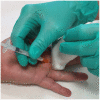Corticosteroid injection treatment for dactylitis in psoriatic arthritis
- PMID: 34471429
- PMCID: PMC8404638
- DOI: 10.1177/1759720X211041864
Corticosteroid injection treatment for dactylitis in psoriatic arthritis
Abstract
Dactylitis - a hallmark clinical feature of psoriatic arthritis (PsA) - that occurs in 30-50% of PsA patients, is a marker of disease severity for PsA progression, an independent predictor of cardiovascular morbidity and impairs the motor functions of PsA patients. There is a paucity of evidence for the treatment due to the absence of randomized controlled trials assessing dactylitis as a primary endpoint and current practice arises from the analysis of dactylitis as a secondary outcome. Corticosteroid (CS) injections for dactylitis in PsA patients are a therapeutic treatment option for patients with isolated dactylitis or for patients with flares in tendon sheaths, despite stable and effective systemic treatment. The aim of this narrative review is to briefly illustrate the clinical aspects of dactylitis in PsA, the imaging and clinimetric tools used to diagnose and monitor dactylitis, the current treatment strategies and principally to provide a comprehensive picture of the clinical efficacy and safety with ultrasound-guide and blind techniques of CS injections for dactylitis in PsA patients.
Keywords: corticosteroid; dactylitis; injection; psoriatic arthritis; tenosynovitis; therapy; treatment; ultrasound.
© The Author(s), 2021.
Conflict of interest statement
Conflict of interest statement: The authors declared no potential conflicts of interest with respect to the research, authorship and/or publication of this article.
Figures





References
-
- Olivieri I, Scarano E, Padula A, et al.. Dactylitis, a term for different digit diseases. Scand J Rheumatol 2006; 35: 333–340. - PubMed
-
- Olivieri I, Scarano E, D’Angelo S, et al.. Dactylitis. In: FitzGerald O, Gladman D. (eds) Oxford textbook of psoriatic arthritis. Oxford: Oxford University Press, 2019, pp. 117–122.
-
- McGonagle D, Tan AL, Watad A, et al.. Pathophysiology, assessment and treatment of psoriatic dactylitis. Nat Rev Rheumatol 2019; 15: 113–122. - PubMed
-
- Rothschild BM, Pingitore C, Eaton M. Dactylitis: implications for clinical practice. Semin Arthritis Rheum 1998; 28: 41–47. - PubMed
-
- Siegel EL, Orbai AM, Ritchlin CT. Targeting extra-articular manifestations in PsA: a closer look at enthesitis and dactylitis. Curr Opin Rheumatol 2015; 27: 111–117. - PubMed
Publication types
LinkOut - more resources
Full Text Sources
Research Materials
Miscellaneous

